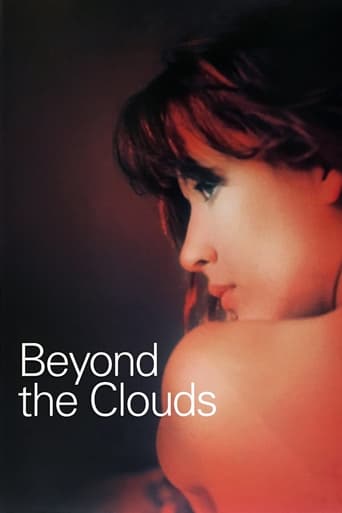

Sadly Over-hyped
... View MoreMemorable, crazy movie
... View MoreI enjoyed watching this film and would recommend other to give it a try , (as I am) but this movie, although enjoyable to watch due to the better than average acting fails to add anything new to its storyline that is all too familiar to these types of movies.
... View MoreThe joyful confection is coated in a sparkly gloss, bright enough to gleam from the darkest, most cynical corners.
... View MoreI must preface this review by saying that I am a massive fan of Antonioni, not only his early (and more popular) works but also the latter films (Zabriskie Point and to a lesser extent Identification of a Woman).First, the positives: the film starts out promising, with some nice camera and compositional work at the beginning. Also Antonioni's eye for casting beautiful, interesting women is still perfectly intact.Now for the bad: the script is hard to stomach, and it also doesn't help that the acting is barely acceptable as well. The music is god-awful; I remember another reviewer comparing it to soft porn, and I think that is a slap in the face to that poor genre. All in all, it's worth viewing if you want to say you've seen every Antonioni film, or you have a love for beautiful women - and in this case it might be better to watch part of the first segment, and then just fast forward to the nude scenes - but don't expect to be presented with the profound artistic statement that you've enjoyed in his other films.
... View MoreSome people do not catch Antonioni. He is one among a very few - less than 50 - capable of magic, even, as he likes to do, when "nothing" happens, or so little. In a way he is very close to the Japanese masters. In fact, since he left neorealism in the 60s, he has ever since shown us the deep fabric of reality that is, the artistic core of every situation, where even the smallest most insignificant detail can open the door to what is really happening. He shows us what really rules in telling a story, what really matters. In very short, you have to be a kind of genius to privilege eye contact and building a relationship over "knowing" (having the information) this young woman killed her father; and you have to be a wizard to make it shine this way. I can understand the joy of Wim Wenders producing this: after all he made "falsche bewegung" in search for something near. To those who don't get Antonioni yet, one must say: get better first and look closer!Maybe you can find just as good in another genre,etc, but his film needs a 10/10: in its kingdom, one cannot go higher, or better.
... View Morealthough the way the film was broken into four parts did appeal to me, much of the dialogue seemed artificial. Jean Reno and Irene Jacob (of course) were excellent. I also liked how Peter Weller's character cut back and forth in languages when he got angry. But the musical score as well as John Malcovichs' portrayal left much to be improved upon. The scenery was excellent... and the atmosphere kept with the theme, but Jacob and Reno really seemed to be carrying too much of a load to bear...ultimately too slow and contrived.
... View MoreThis is a special film if you know the context. Antonioni, in his eighties, had been crippled by a stroke. Mute and half paralyzed, his friends -- who incidentally are the best the film world has -- arranged for him to 'direct' a last significant film. The idea is that he can conjure a story into being by just looking at it. So we have a film: about a director who conjures stories by simple observation. And the matter of the (four) stories is about how the visual imagination defines love.The film emerges by giving us the tools to bring it into being through our own imagination. The result is pure movie-world: every person (except the director) is lovely in aspect or movement. Some of these women are ultralovely, and they exist in a dreamy misty world of sensual encounter. There is no nuance, no hint that anything exists but what we see; no desire is at work other than what we create.I know of no other film that so successfully manipulates our own visual yearning to have us create the world we see. He understands something about not touching. No one understands Van Morrison visually like he does. Morrison's Celtic space music is predicated on precisely the same notion: the sensual touch that implies but doesn't physically touch.Antonioni's redhead wife appears, appropriately as the shopkeeper and she also directs a lackluster 'making of' film that is on the DVD.Ted's Evaluation -- 3 of 4: Worth watching.
... View More